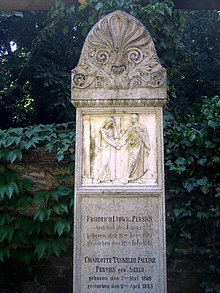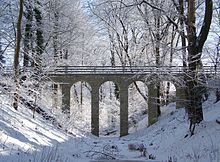Ludwig Persius

Ludwig Persius (born February 15, 1803 in Potsdam ; † July 12, 1845 there ) was a Prussian architect and student of Karl Friedrich Schinkel . Persius assisted Schinkel with the construction of Charlottenhof Palace and the Roman baths in Sanssouci Park in Potsdam . He was also involved in the construction of the Great Fontaine (in front of Sanssouci Palace ), the Church of Peace , the Orangery and the Norman Tower (on the ruin hill , opposite Sanssouci Palace).
Life
Ludwig Persius attended the community school and grammar school in Potsdam. From 1817 to 1819 he worked for the building inspector Gotthilf Hecker; he enrolled in the carpentry trade . In 1819 he began a surveyor training at the building academy in Berlin and in March 1821 passed the surveyor examination. From 1821 Persius worked as a construction manager in Potsdam, including under Karl Friedrich Schinkel in the construction of the palace and church on the property of Count Potocki near Krakow . In 1824 he became a member of the Berlin Architects' Association . In Glienicke Palace he worked as a construction architect under Schinkel. In 1826 he passed the master builder examination at the building academy in Berlin and became a building manager in Charlottenhof .
In 1827 Persius married Pauline Sello (1808–1883), sister of Hermann Ludwig Sello from the famous Sello gardener family . From this marriage the daughters Elisabeth (1829–80) and Marie (1834–47), as well as the sons Ludwig Paul (1832–1902), Reinhold (1835–1912), Conrad (1836–1903) and Felix (1842–1885) went ).
In 1829 he became a building inspector with the royal government in Potsdam. His first independent construction took place in 1833: he converted the art mills (near the Roman baths ) into a house for the gardener Handmann. In 1834 he became royal court building inspector.
In 1840 he undertook a trip to the Rhine, which brought him to Heidelberg and Bacharach as well as to Stolzenfels Castle and Ehrenbreitstein Fortress . In 1841 he traveled to Paris, where he also visited Munich , Strasbourg , Andernach , Rolandseck , Bad Godesberg and Cologne . In 1842 he took another trip: Lehnin , Chorin , Halle and as far as Erfurt .
In 1841 Friedrich Wilhelm IV appointed Persius to be his court architect. In 1842 he became a royal building officer and member of the senior building management. In 1843/44 Persius also worked for Prince Pückler-Muskau , among others .
In 1843 another trip took him to the Rhine (including Bingen , Bad Godesberg and Trier ). In 1844 he traveled to Bad Muskau and Holland . In 1845 he made a trip to Italy : via Nîmes , Marseille and Genoa , to Rome , Naples , Vicenza , Padua , Venice and Verona .
In 1845 Persius was appointed senior building officer retroactively to October 12, 1842. He died on July 12, 1845 and was buried in the cemetery of the Hermann Sello Family Foundation, part of the Bornstedt cemetery near Potsdam.
Works
Buildings in collaboration with Schinkel
- 1821, castle and church on the estate of Count Potocki near Cracow
- 1829–32, gardener's house in the park of Sanssouci near the Roman baths
Structures (preserved)
- 1833, Handmann house in the park of Sanssouci near the Roman baths
- 1834/35, Fähr- und Fischerhaus Uetz (in Uetz-Paaren , near Potsdam )
- 1837/38, manor house of the von Schierstedt in Gräben-Dahlen
- 1838/39, gardener's and machine house, Teufelsbrücke as well as the orangery and greenhouses in Glienicke Park (in Berlin-Wannsee )
- 1840, Stibadium in Glienicke Park (in Berlin-Wannsee)
- 1840/41, duck-catching establishment at the Potsdam Wildlife Park (in Geltow, Schwielowsee municipality ) and renovation of the side wings of Sanssouci Palace
- 1840–1842, reconstruction of Glienicke Palace (in Berlin-Wannsee)
- 1841, Prinzliche Unterförsterei Moorlake (in Berlin-Wannsee); first drafts for the Friedenskirche (executed in 1844)
- 1841/42, Hirschtor in Glienicke Park; first, second and third forester establishment and the Hegemeisterhaus in the wildlife park ; Designs for the dome of the Church of St. Nikolai (executed in 1850)
- 1841–1843, conversion of the royal civil cabinet (in Potsdam, avenue to Sanssouci 6); Hofgärtnerhaus Sello (today: Villa Kache, in Potsdam, Maulbeerallee 2); Steam engine house for Sanssouci (in Potsdam, Breite Straße 28); Steam mill of the former Prussian Sea Trade (in Potsdam, Zeppelinstraße 136, since 2016 location of the first professional training center in Potsdam for people with mental disabilities)
- 1841–1844, Heilandskirche and Roman Bank in Potsdam-Sacrow (Krampnitzer Straße 9); Fountains and small architecture in Park Sanssouci ; Atrium and pergola in the Paradiesgärtlein (completed until 1848; Maulbeerallee, today part of the Botanical Garden of the University of Potsdam )
- 1842, northern extensions of the picture gallery and reconstruction of the new chambers (west of the Sanssouci Palace); Draft of the exedra on the ruin mountain (executed in 1843/44)
- 1842–44, Fasanerie Charlottenhof (in Potsdam, Geschwister-Scholl-Strasse 36)
- 1842/43, draft for the grain magazine on the premises of the Proviantamt (in Potsdam, Leipziger Straße 7/8); Jägertor in Glienicke Park (in Berlin-Wannsee)
- 1843, Swiss style sailor house in Glienicke Park (in Berlin-Wannsee); Design for the Villa Tieck (executed in 1845/46; in Potsdam, Schopenhauerstraße 24); Design for the Ahok residential building (executed in 1845; in Potsdam, Weinbergstrasse 9); Plans for the renovation of the Villa Illaire (former home of the court gardener Voss; carried out until 1846)
- 1843/44, Brandt house (in Potsdam, Zeppelinstrasse 189); Orangery in the Fürst-Pückler-Park in Bad Muskau ; Viaduct in Potsdam-Bornstedt ( Teufelsgrabenbrücke over the Bornstedter piercing); Preacher's house in Lehnin; Reconstruction and extension of the dairy in the New Garden
- 1843–1845, expansion of Babelsberg Palace ; Engine house and porter's house in Potsdam-Babelsberg ; Villa Tiedke (in Potsdam, Reiterweg 1); Villa Schöningen (in Potsdam, Berliner Strasse 86)
- 1844, designs for Lindstedt Palace (modified; in Potsdam); Draft for the Norman Tower on the Ruinsberg ( executed in 1845 under court building officer Ferdinand von Arnim ); Design for the Nedlitz Fährgutshaus (in Potsdam- Neu Fahrland , Tschudistraße 1); Bornim farmstead (only the tower is preserved; in Potsdam, Max-Eyth-Allee); Home of the master carpenter Rietz (in Potsdam-Bornstedt, Ribbeckstrasse 22); Design for the church in Saarmund (executed 1846–48)
- 1844–1846 construction of the Villa Tiedke (in Potsdam, Reiterweg 1)
- 1844/45, conversion of the Minerva Lodge (in Potsdam, Kiezstrasse 10)
- 1845, farmyard in Glienicke Park (in Berlin-Wannsee ); Design for the church in the forest in Heringsdorf (executed 1846–48); Design for the Bethanien Hospital in Berlin, carried out until 1847 according to plans by Theodor August Stein and Friedrich August Stüler
Buildings (not preserved)
- 1835–39, Villa Jacobs (demolished after fire in 1981, reconstructed from 2006–08 on the foundation that was preserved)
- 1837, Villa Persius (destroyed in World War II, rebuilt in 2014 in the historical cubature)
- 1837, stable building (Schweizerhaus) at the historic mill in Sanssouci Park
- 1842, gangway over the Potsdam city canal
- 1842/43, Kneib steam cutting mill
- 1842/43, Jacobs sugar boiler
- 1844, planning of the Nedlitz North Bridge (executed in 1853/54 by Carl Ferdinand Busse , demolished in 2001 despite being listed )
- 1844, conversion of the Sacrow ferry leaseholder house into an inn "Zum Doktor Faust" in Potsdam-Sacrow (demolished in 1961 when the border barriers were built)
- 1845–51, reconstruction of the Barberini Palace , carried out by Ludwig Ferdinand Hesse (reconstructed until 2016 after being destroyed in the Second World War)
literature
- Lionel von Donop : Persius, Ludwig . In: Allgemeine Deutsche Biographie (ADB). Volume 25, Duncker & Humblot, Leipzig 1887, pp. 390-392.
- Inken Baller: Persius continued to build. In: Foundation Prussian Palaces and Gardens Berlin-Brandenburg. Jahrbuch 5 (2003), pp. 237–242 ( digitized from perspectivia.net , accessed on February 28, 2013).
- Barry Bergdoll: From Potsdam to Chicago: The reception of Ludwig Persius by modern architects and art historians. In: Foundation Prussian Palaces and Gardens Berlin-Brandenburg. Jahrbuch 5 (2003), pp. 221–235 ( digitized on perspectivia.net , accessed on February 28, 2013).
- Eva Börsch-Supan : Ludwig Persius. The diary of the architect Friedrich Wilhelm IV. Deutscher Kunstverlag, Munich 1980, ISBN 978-3422007185
- Eva Börsch-Supan: Persius, Friedrich Ludwig. In: New German Biography (NDB). Volume 20, Duncker & Humblot, Berlin 2001, ISBN 3-428-00201-6 , p. 198 f. ( Digitized version ).
- Eva Börsch-Supan: Ludwig Persius - undemanding championship. In: Foundation Prussian Palaces and Gardens Berlin-Brandenburg. Jahrbuch 5 (2003), pp. 3–8 ( digitized from perspectivia.net , accessed on February 28, 2013).
- Sabine Bohle-Heintzenberg / Manfred Hamm: Ludwig Persius. Architect of the king. Gebrüder Mann Verlag 2002, ISBN 978-3786117131
- Ludwig Persius - architect of the king, architecture under Friedrich Wilhelm IV. Ed. By the Prussian Palaces and Gardens Foundation Berlin-Brandenburg, Potsdam 2003, ISBN 978-3795415860
- Axel Föhl: marble, stone and iron. Ludwig Persius and the industrial architecture of the 19th century. In: Foundation Prussian Palaces and Gardens Berlin-Brandenburg. Jahrbuch 5 (2003), pp. 113–126 ( digitized from perspectivia.net , accessed on February 28, 2013).
- Stefan Gehlen: "How happy I am to be able to continue to work on this building in the spirit of my dear master". To Pliny reception by Karl Friedrich Schinkel and Ludwig Persius in Babelsberg. In: Foundation Prussian Palaces and Gardens Berlin-Brandenburg. Jahrbuch 5 (2013), pp. 71–82 ( digitized from perspectivia.net , accessed on February 28, 2013).
- Robert Graefrath: Sacrow. The Heilandskirche am Port: How Ludwig Persius, Friedrich Wilhelm IV. And Carl Begas composed the interior in the delicate-sized vessel. In: Foundation Prussian Palaces and Gardens Berlin-Brandenburg. Jahrbuch 5 (2003), pp. 31-46 ( digitized on perspectivia.net , accessed on February 28, 2013).
- Hillert Ibbeken: Ludwig Persius - The Architectural Work Today / The Architectural Work Today. Edition Axel Menges 2005, ISBN 978-3932565465
- Andreas Kitschke: In search of consensus. The relationship between Ludwig Persius and Friedrich Wilhelm IV. And his professional colleagues at home and abroad. In: Foundation Prussian Palaces and Gardens Berlin-Brandenburg. Jahrbuch 5 (2003), pp. 9-18 ( digitized on perspectivia.net , accessed on February 28, 2013).
- Katharina Lippold: Brick and terracotta - important details of Persius' Italian dream. In: Foundation Prussian Palaces and Gardens Berlin-Brandenburg. Jahrbuch 5 (2003), pp. 105–112 ( digitized from perspectivia.net , accessed on February 28, 2013).
- Andreas Meinecke: Persius' building recordings of the monastery church Chorin against the background of the development of monument preservation under Friedrich Wilhelm IV. In: Foundation Prussian Palaces and Gardens Berlin-Brandenburg. Jahrbuch 5 (2003), pp. 19–30 ( digitized on perspectivia.net , accessed on February 28, 2013).
- Andreas Meinecke (arrangement): Ludwig Persius. Construction reports, letters and architectural reports. An annotated source edition . Edited by the Prussian Palaces and Gardens Foundation Berlin-Brandenburg. Deutscher Kunstverlag, Munich 2006, ISBN 3-422-06634-9
- Marcel Piethe: The master builder Ludwig Persius in Potsdam and the Mark Brandenburg. in: Die Mark Brandenburg , Issue 76, Berlin 2010, ISBN 978-3-910134-10-2
Web links
- Literature by and about Ludwig Persius in the catalog of the German National Library
- Ludwig Persius. In: arch INFORM .
- Drawings by Ludwig Persius in the Architekturmuseum der TU Berlin
- Term paper about Persius: http://www.a.tu-berlin.de/student/elmo/persius.htm
| personal data | |
|---|---|
| SURNAME | Persius, Ludwig |
| ALTERNATIVE NAMES | Persius, Friedrich Ludwig |
| BRIEF DESCRIPTION | architect |
| DATE OF BIRTH | February 15, 1803 |
| PLACE OF BIRTH | Potsdam |
| DATE OF DEATH | July 12, 1845 |
| Place of death | Potsdam |





